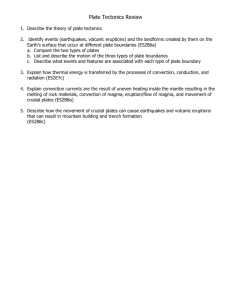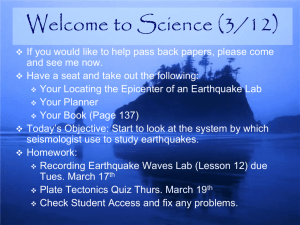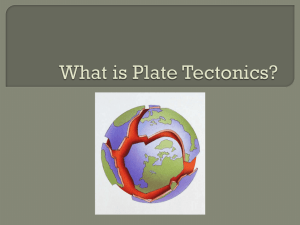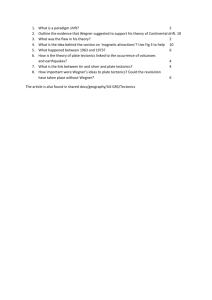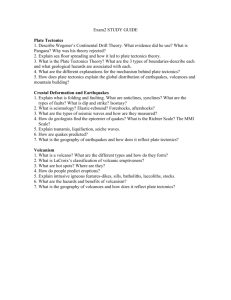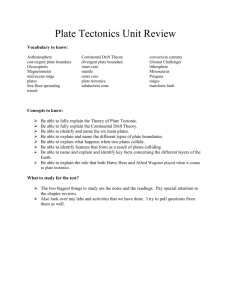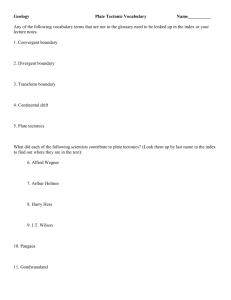Science SCI.V.1.2 ...
advertisement
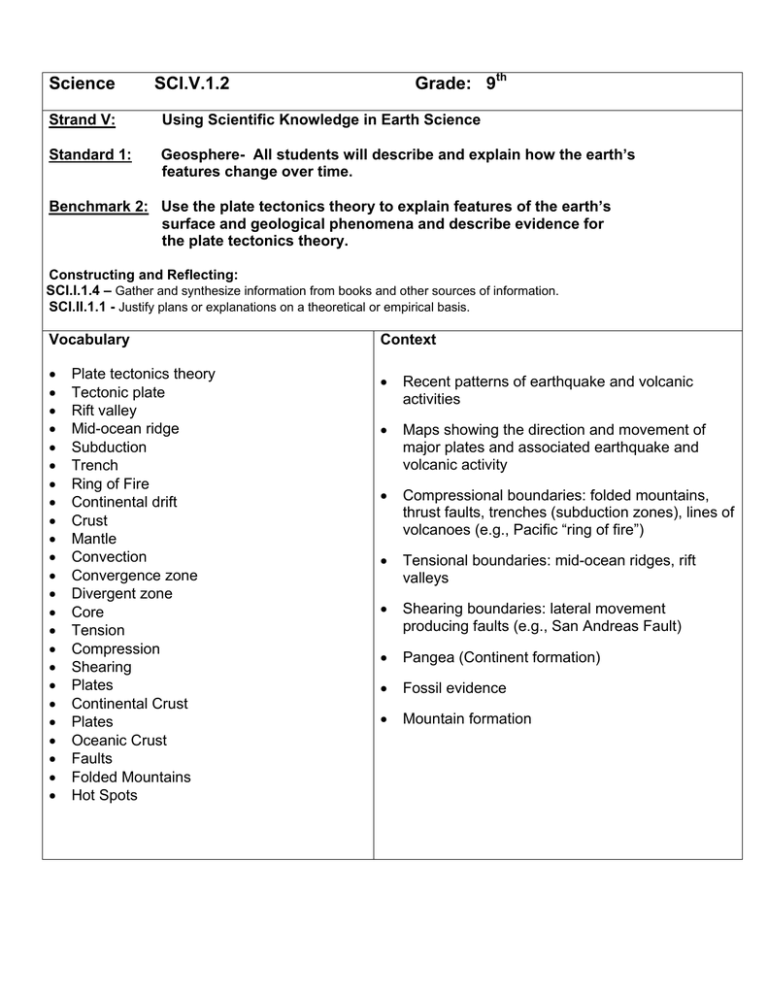
Science Grade: 9th SCI.V.1.2 Strand V: Using Scientific Knowledge in Earth Science Standard 1: Geosphere- All students will describe and explain how the earth’s features change over time. Benchmark 2: Use the plate tectonics theory to explain features of the earth’s surface and geological phenomena and describe evidence for the plate tectonics theory. Constructing and Reflecting: SCI.I.1.4 – Gather and synthesize information from books and other sources of information. SCI.II.1.1 - Justify plans or explanations on a theoretical or empirical basis. Vocabulary • • • • • • • • • • • • • • • • • • • • • • • • Plate tectonics theory Tectonic plate Rift valley Mid-ocean ridge Subduction Trench Ring of Fire Continental drift Crust Mantle Convection Convergence zone Divergent zone Core Tension Compression Shearing Plates Continental Crust Plates Oceanic Crust Faults Folded Mountains Hot Spots Context • Recent patterns of earthquake and volcanic activities • Maps showing the direction and movement of major plates and associated earthquake and volcanic activity • Compressional boundaries: folded mountains, thrust faults, trenches (subduction zones), lines of volcanoes (e.g., Pacific “ring of fire”) • Tensional boundaries: mid-ocean ridges, rift valleys • Shearing boundaries: lateral movement producing faults (e.g., San Andreas Fault) • Pangea (Continent formation) • Fossil evidence • Mountain formation Knowledge and Skills Students will: • Interpret the early evidence of continental movements, such as similarities across continents in existing animals, plants, fossils, shoreline shapes, and rock layer sequences. • Illustrate how seafloor bedrock patterns and age (paleo-magnetism) provide convincing evidence of plate motions. • Differentiate between continents and plates. • Identify plate boundaries as lines of earthquakes on a world earthquake map. • Describe the causes of earthquakes as compression (plates moving together), tension (plates moving apart), or shearing (plates sliding sideways). Resources Coloma Resources: Glencoe CH 16.2 Seafloor CH 17 Plate Tectonics CH 18 Volcanic Activity CH 19 Earthquakes CH 20 Mountain Building Glencoe Lab 17.1 magnetism & ocean ridges Other Resources: • Michigan Teacher Network Resources • USGS Explanation of Plate Tectonics: major types of plate boundaries with geographic examples. • Plate Tectonics and the Cause of Earthquakes • CEEP (Crustal Evolution Education Project Modules). National Association of Geology Teachers • Causes of earthquakes, volcanoes, and tsunamis with animations. http://www.thirteen.org/savageearth/ • Scope Unit – Earth Movers (eighth) • Earthquakes. http://www.thetech.org/hyper/quakes/intro/ • Plate tectonics. http://www.ucmp.berkeley.edu/geology/tectonics.html • Plate tectonics modules, hurricanes, El Nino, wind and ozone depletion. MESTA, 2000.1. http://kids.earth.nasa.gov/ • Seismological Laboratory. http://www.seismo.unr.edu/htdocs/seismolab.html • Tectonics and ocean floor data. MESTA, 2000.1. http://www.ngdc.noaa.gov/ • Volcanoes. Http://volcano.und.nodak.edu/volcanoes.html Instruction Benchmark Question: What evidence is there that the Earth’s outer layer is composed of large pieces that are moving? Focus Question: How can the location of earthquakes be used to show plate boundaries? The teacher will provide each student with a world map. Assessment Each student will be given a world map including epicenter locations along with magnitude and depth to hypocenter data. “Hypocenter” is a modern alternative to “focus,” the place underground where the slippage actually began. The teacher will assign a particular plate to each student. The student will analyze that plate’s boundaries and distinguish between tensional and compressional boundaries. Students will research earthquake location data for a period of many years using the internet or other sources. The teacher will demonstrate how to plot epicenters by using a website that automatically plots them over a period of years. Working with a partner, students will plot epicenters on the map using latitude and longitude. Note: A tensional plate boundary is characterized by shallow hypocenter, lower magnitude quakes. A compressional boundary involving an ocean plate is often a subduction zone where quakes are arranged in deepening bands under the continent and where magnitudes tend to be greater. Extension: Students can distinguish the nature of plate boundaries based on earthquake magnitudes: compressional (larger magnitudes, shallow to deep hypocenters, subduction common) and tensional (smaller magnitudes, shallow hypocenters, rifting common. Write a 5 paragraph compare and contrast essay on plates vs. continents. Paleomagnetism labs, see appendix Corresponds to standard I.1.4 (Give students rubric before activity.) Create a model or timeline that shows the sequence of an earthquake Criteria Apprent. Basic Meets Exceeds Analysis of data Identifies one: either type of boundary, depth of hypocenters, or magnitudes. Identifies two: boundary and either depth of hypocenter s or magnitude. Identifies all three: types of boundary, depth of hypo centers, and magnitude of quakes. Identifies and explains with the aid of a diagram the relationships between type of boundary, depth of hypocenters, and magnitude of quakes. Teacher Notes: Describe and explain how the earth's features change over time. As students gain understanding, they start to explore the dynamics of the geosphere. They come to realize that the earth's features are constantly changing, some of these changes are immediate and some take eons. Wind and water erode away mountains and hills. Ice and heat break apart rocks. Rivers cut new valleys and dams form new lakes. Volcanoes and earthquakes form new mountains and hills. Wind and water combine to build sand dunes and then turn around and erode them away. The forces that work to change the surface of the earth in this continuing dynamic are tremendous and sometime even catastrophic. A volcano can explosively form a mountain or island in a matter of hours, while rivers can take decades to carve out valleys. The evidence for these changes is abundant. By studying rock layers, and fossils, (i.e., mineralized replacements or casts of ancient life forms), students learn the history of the geosphere. They discover that these fossils are found in many places, and that rock layers can become inverted. Marine plants and animals are found on mountaintops and in limestone deposits in the Great Lakes area. Creatures from rain forests have left fossilized remains in current deserts, and plains animals are found in frozen in artic ice. From road cuts they will see how the earth is folded to a point where layers of rock are reversed. In the Great Lakes Basin they observe a history that goes from salt-water seas, to inland swamps, to high plateaus, to the largest collection of fresh water on the planet. Students will continue to gain understanding of the geosphere as they discover that similar processes form rocks and minerals. They will learn of the tremendous amount of heat and pressure involved in their formation. They will also observe how changes in temperature from melting to freezing and vise versa changes big features into little ones. Rocks are fractured through this process. Water in small cracks and crevices of rocks can freeze, expanding as it freezes and breaking the rock into small pieces. Students will notice how microorganisms help turn rocks into soil, and how they turn organic materials back into minerals, thus returning needed materials to the earth. With the help of media presentations about volcanoes and earthquakes, students will observe the movement of the Earth's crust. This will lead to an understanding of the dynamics of the earth's interior- its core, a dynamic that can build mountains. From this knowledge of the fluidity, tremendous heat and pressure that are involved in the dynamics of the earth's core, comes an understanding of what leads scientists to theorize the movement of plates in the earth, the study of plate tectonics.
